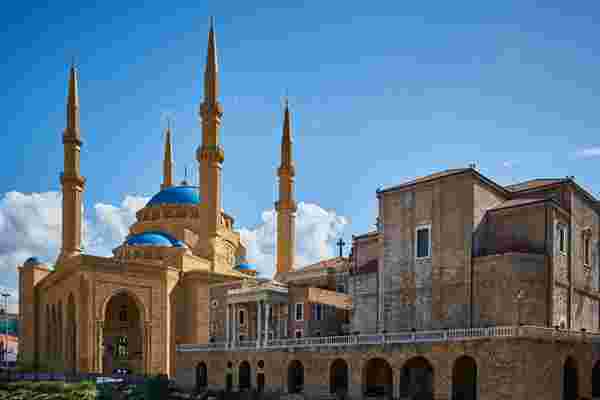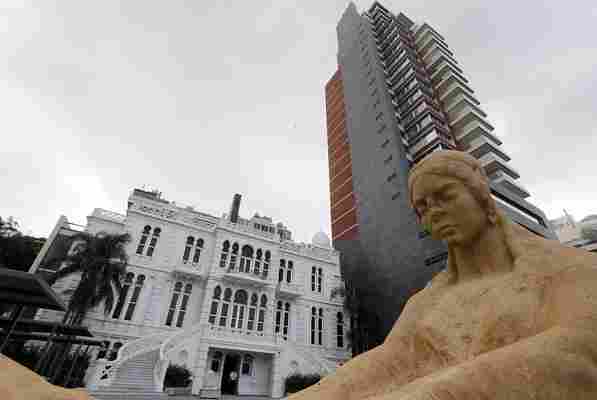Anyone paying cursory attention to Beirut’s architectural evolution in recent years will have been impressed. From Zaha Hadid’s Issam Fares Institute and Foster and Partner’s 3Beirut to Herzog & de Meuron’s Beirut Terraces and David Adjaye's Aishti Foundation , the city’s architecture has become increasingly sophisticated and international.
Following Tuesday’s massive explosion, however, Beirut has once again become known for destruction. The blast originated in a warehouse containing 2,750 tons of ammonium nitrate, located several hundred feet from two of its most historic neighborhoods, Gemmayzeh and Mar Mikhael —the latter a nucleus of galleries, design boutiques and workshops, and an integral stop during Beirut’s annual Design Week .
Among the 135 confirmed dead at time of writing, is architect Jean-Marc Bonfils, whose cantilevered East Village apartments introduced Beirut to living walls, and served as a contemporary counterpoint to Pierre Neema’s 1965 Brazilian-inspired behemoth, Électricité du Liban headquarters , which is again, following this week’s explosion, a ruin. Chillingly, Bonfils’ last social media post was a video of the burning warehouse shortly before it detonated.
The blast blew out windows over nine miles away, and destroyed or rendered structurally unsound so many buildings in eastern and central Beirut that the city’s governor, Marwan Abboud, has stated upwards of 300,000 people face homelessness .
Of course, some of the city’s structures fared better than others. Though perilously close to the blast site, Lina Ghotmeh’s hulking Stone Garden tower survived thanks to its favoring of mass over glass, a tactic used to striking aesthetic effect, but which echoes the architecture of the civil war, when small windows and thick expanses of concrete were comforting.
Even by Beirut’s tumultuous standards, Tuesday’s blast was unprecedented, and the footage shared on social media was so immediately reminiscent of 1950s nuclear test films, it led to the coining of a new Arabic hashtag: ‘ Beirutishima ’.
This content can also be viewed on the site it originates from.
If the city’s glass walls have been shattered, its cultural heritage has also taken a battering. Saving Beirut’s beguiling Levantine genus of Ottoman-Venetian architecture was never easy and there are fears that the city may use the destruction as an excuse to erase, not restore.

Beirut’s iconic St. George Maronite Cathedral close to the Mohammad Al-Amin Mosque.
“After 17 years of urban planning in Beirut, the biggest obstacle to sustainable development is our structure of governance,” explained Amira Solh, an urban planning consultant, who formerly worked with the company charged with Beirut’s post-war reconstruction, Solidere . “Our municipality is the richest and most corrupt in the country, and there’s no trust they’ll set up proper guidelines. We already lost most of our heritage buildings before this explosion. Now, while we scramble to save lives, they’re already manipulating the price of glass.”
Her concerns are echoed by entrepreneur Nabil Debs, who nevertheless views the tragedy as an opportunity to force authorities to act responsibly towards its remaining heritage. The owner of Arthaus , a boutique hotel occupying a cluster of 18 th and 19 th century sandstone homes in Gemmayzeh, Debs is still taking stock of the damage, but he plans to have the hotel back in business within a month.
“The damage I’ve seen elsewhere is mainly to roofs and elevated windows; ground floors and lower levels are in better shape,” he says. “What saved the city, and our homes, is the fact that the blast was fireless, otherwise the whole area would have disappeared.”
On a positive note, Beirut municipality has begun sending teams out to assess structural damage, though some locals fear this may just be an excuse to condemn structures that could be saved, while people are preoccupied.
While few Beiruti buildings have been spared, heritage buildings face a greater battle, as repairs are extremely costly. Just up the hill from Mar Mikhael, the ornate Sursock Museum , which reopened in 2015 after an ambitious underground expansion by Jacques Aboukhaled and Jean-Michel Wilmotte, suffered severe external and internal damage. Also impacted was the crème brûlée-colored Levantine-Venetian palazzo nearby, home to the Sursock family for over 160 years, which has reportedly lost sections of its red-tiled roof, its elegant arched windows, and several exterior balconies.

Beirut’s recently restored Sursock Museum.
Lovingly restored by Lady Cochrane Sursock , a powerhouse of Beirut’s architectural preservation scene, and her son Roderick and his American wife, Mary, it is once again a mess of fallen ceilings, broken chandeliers, and shattered moldings, its marble mosaic floors carpeted in shattered remains. Fixing it again will cost millions.
So, will Beirut recover? By any standards, even their own, the Lebanese have been through hell in recent years. Faced with their latest apocalypse, residents are doing what they have done too often before; caring for the wounded, sweeping up the rubble, boarding up windows and somehow, carrying on.
Beirut is famously resilient. It will rise again, and open its arms to the world. But for some, the losses have already proven too great. After years of economic challenges , not all bars, restaurants, and galleries —let alone homeowners—may have the means to start again.